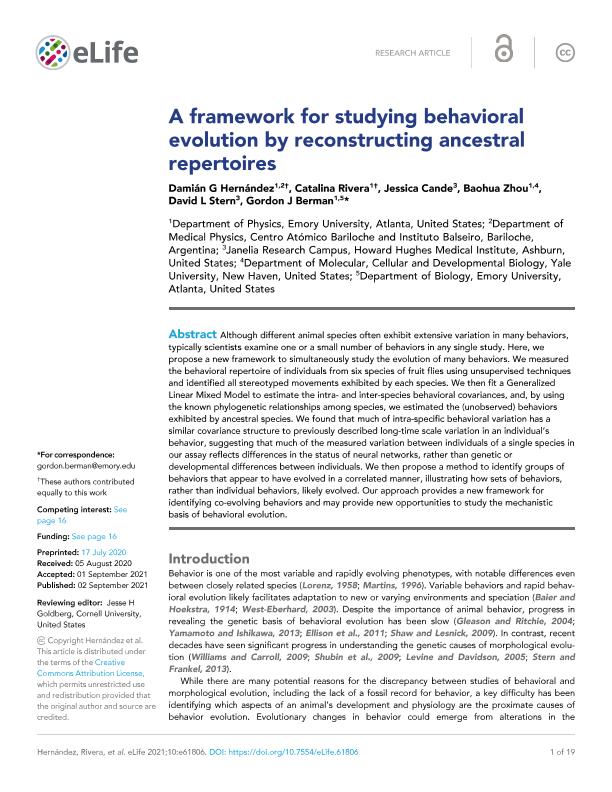Mostrar el registro sencillo del ítem
dc.contributor.author
Hernández Lahme, Damián Gabriel

dc.contributor.author
Rivera, Catalina
dc.contributor.author
Cande, Jessica
dc.contributor.author
Zhou, Baohua
dc.contributor.author
Stern, David L.
dc.contributor.author
Berman, Gordon J.
dc.date.available
2022-09-06T13:58:13Z
dc.date.issued
2021-09
dc.identifier.citation
Hernández Lahme, Damián Gabriel; Rivera, Catalina; Cande, Jessica; Zhou, Baohua; Stern, David L.; et al.; A framework for studying behavioral evolution by reconstructing ancestral repertoires; eLife Sciences; eLife; 10; 9-2021; 1-19
dc.identifier.issn
2050-084X
dc.identifier.uri
http://hdl.handle.net/11336/167556
dc.description.abstract
Although different animal species often exhibit extensive variation in many behaviors, typically scientists examine one or a small number of behaviors in any single study. Here, we propose a new framework to simultaneously study the evolution of many behaviors. We measured the behavioral repertoire of individuals from six species of fruit flies using unsupervised techniques and identified all stereotyped movements exhibited by each species. We then fit a Generalized Linear Mixed Model to estimate the intra-and inter-species behavioral covariances, and, by using the known phylogenetic relationships among species, we estimated the (unobserved) behaviors exhibited by ancestral species. We found that much of intra-specific behavioral variation has a similar covariance structure to previously described long-time scale variation in an individual’s behavior, suggesting that much of the measured variation between individuals of a single species in our assay reflects differences in the status of neural networks, rather than genetic or developmental differences between individuals. We then propose a method to identify groups of behaviors that appear to have evolved in a correlated manner, illustrating how sets of behaviors, rather than individual behaviors, likely evolved. Our approach provides a new framework for identifying co-evolving behaviors and may provide new opportunities to study the mechanistic basis of behavioral evolution.
dc.format
application/pdf
dc.language.iso
eng
dc.publisher
eLife Sciences
dc.rights
info:eu-repo/semantics/openAccess
dc.rights.uri
https://creativecommons.org/licenses/by/2.5/ar/
dc.subject
behavior
dc.subject
evolution
dc.subject
variation
dc.subject
Drosophila
dc.subject.classification
Biofísica

dc.subject.classification
Ciencias Biológicas

dc.subject.classification
CIENCIAS NATURALES Y EXACTAS

dc.subject.classification
Biología

dc.subject.classification
Ciencias Biológicas

dc.subject.classification
CIENCIAS NATURALES Y EXACTAS

dc.title
A framework for studying behavioral evolution by reconstructing ancestral repertoires
dc.type
info:eu-repo/semantics/article
dc.type
info:ar-repo/semantics/artículo
dc.type
info:eu-repo/semantics/publishedVersion
dc.date.updated
2022-08-30T20:02:59Z
dc.journal.volume
10
dc.journal.pagination
1-19
dc.journal.pais
Reino Unido

dc.description.fil
Fil: Hernández Lahme, Damián Gabriel. University of Emory; Estados Unidos. Comisión Nacional de Energía Atómica. Gerencia del Área de Energía Nuclear. Instituto Balseiro; Argentina. Consejo Nacional de Investigaciones Científicas y Técnicas. Centro Científico Tecnológico Conicet - Patagonia Norte; Argentina
dc.description.fil
Fil: Rivera, Catalina. University of Emory; Estados Unidos
dc.description.fil
Fil: Cande, Jessica. Howard Hughes Medical Institute; Estados Unidos
dc.description.fil
Fil: Zhou, Baohua. University of Yale; Estados Unidos. University of Emory; Estados Unidos
dc.description.fil
Fil: Stern, David L.. Howard Hughes Medical Institute; Estados Unidos
dc.description.fil
Fil: Berman, Gordon J.. University of Emory; Estados Unidos
dc.journal.title
eLife
dc.relation.alternativeid
info:eu-repo/semantics/altIdentifier/url/https://elifesciences.org/articles/61806
dc.relation.alternativeid
info:eu-repo/semantics/altIdentifier/doi/http://dx.doi.org/10.7554/eLife.61806
Archivos asociados
